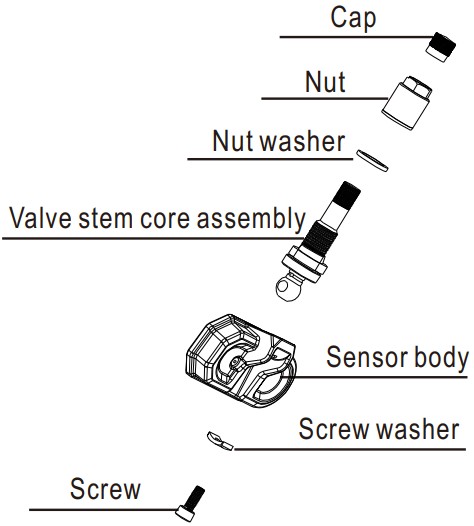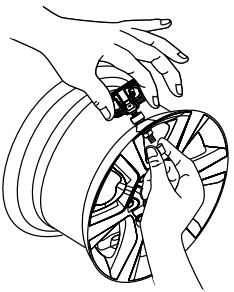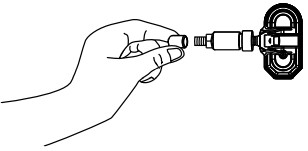![]() LAUNCH TSENSOR-B
LAUNCH TSENSOR-B
Programming-free Bluetooth®
Tire Pressure Sensor
User Manual
![]() IMPORTANT: Read these instructions carefully and use this unit properly before operating. Failure to do so may cause damage and/or personal injury and will void the product warranty.
IMPORTANT: Read these instructions carefully and use this unit properly before operating. Failure to do so may cause damage and/or personal injury and will void the product warranty.
 Safety Instructions
Safety Instructions
Any maintenance and repair work must be carried out by trained experts.
Failure to do so may result in the failure of the TPMS sensor. LAUNCH does not assume any liability in case of faulty or incorrect installation of the unit.
Warranty
The sensor is guaranteed to be free from material and manufacturing defects for a period of twenty-four (24) months or for 24800 miles, whichever comes first. This warranty covers any defects in materials or workmanship under normal use during the warranty
period.
Excluded from the warranty are defects due to improper installation and usage, induction of defect by other products, damage due to collision or tire failure.
For Service & Support
![]() +86-755-84557891
+86-755-84557891
![]() overseas.service@cnlaunch.com
overseas.service@cnlaunch.com
![]() https://en.cnlaunch.com
https://en.cnlaunch.com
Caution
![]() When mounting/dismounting the wheel, follow the operation guideline of wheel changer manufacturer strictly.
When mounting/dismounting the wheel, follow the operation guideline of wheel changer manufacturer strictly.
![]() Do not race with the vehicle on which the LAUNCH TSENSOR-B sensor is mounted, and always keep the drive speed under 240km/h.
Do not race with the vehicle on which the LAUNCH TSENSOR-B sensor is mounted, and always keep the drive speed under 240km/h.
![]() To guarantee optimal performance, the sensors may only be installed with original valves and accessories provided by LAUNCH.
To guarantee optimal performance, the sensors may only be installed with original valves and accessories provided by LAUNCH.
![]() Make sure to program the sensors using LAUNCH-specific TPMS tool prior to installation.
Make sure to program the sensors using LAUNCH-specific TPMS tool prior to installation.
![]() Do not install programmed TPMS sensors in damaged wheels.
Do not install programmed TPMS sensors in damaged wheels.
![]() After installing the TPMS sensor, test the vehicle’s TPMS following the steps described in the original manufacturer’s user manual to confirm proper installation.
After installing the TPMS sensor, test the vehicle’s TPMS following the steps described in the original manufacturer’s user manual to confirm proper installation.
Compliance Information
FCC ID: XUJLTB
IC: 29886-LAUNCHTLB
Any changes or modifications not expressly approved by the party responsible for compliance could void the user’s authority to operate the equipment.
This device complies with Part 15 of the FCC Rules and Industry Canada licence-exempt RSS standard(s). Operation is subject to the following two conditions: (1) This device may not cause harmful interference, and (2) This device must accept any interference received, including interference that may cause undesired operation.
This device is in compliance with the essential requirements and other relevant provisions of Radio Equipment Directive 2014/53/EU. The RF frequencies can be used in Europe without restriction.
Components & Controls

Technical Parameters
Weight: <36.2g
Dimension: About 82.7*59.4*18mm
Frequency: 2.4GHz
IP Rating: IP67
Working Voltage: 3V
![]() When replacing or servicing the sensor, please only use the original valves and accessories provided by LAUNCH to ensure proper sealing. It is mandatory to replace the sensor if it is externally damage. Always remember to tighten the nut to the correct torque of 4N·m.
When replacing or servicing the sensor, please only use the original valves and accessories provided by LAUNCH to ensure proper sealing. It is mandatory to replace the sensor if it is externally damage. Always remember to tighten the nut to the correct torque of 4N·m.
Installation Steps
1. Loosening the tire
Remove the valve cap and nut and deflate the tire.
Use the bead loosener to break the tire bead.
![]() Caution: The bead loosener must be facing the valve.
Caution: The bead loosener must be facing the valve.

2. Dismounting the tire
Clamp the tire on the tire changer, and adjust the valve at 1 o’clock to the tire fitting head. Use the tire tool to dismount the tire bead.

![]() Caution: Always observe this starting point during the whole dismounting process.
Caution: Always observe this starting point during the whole dismounting process.
3. Dismounting the sensor
Remove the cap and nut from the valve stem, and then remove the sensor assembly from the wheel rim.

4. Mounting the sensor and valve
Step 1. Remove the cap and nut from the valve stem.

Step 2. Place the valve stem through the valve hole of the rim, ensuring the sensor body located on the inside of the rim. Assemble the nut back on the valve stem with a torque of 4N·m, then tighten the cap.
![]() Caution: Make sure that the nut and cap are installed on the outside of the rim.
Caution: Make sure that the nut and cap are installed on the outside of the rim.

5. Remounting the tire
Place the tire on the rim, ensure that the valve starts on the opposite side of the rim from the tire fitting head. Mount the tire over the rim.
![]() Caution: Strictly follow tire changer manufacturer’s instructions to mount the tire.
Caution: Strictly follow tire changer manufacturer’s instructions to mount the tire.

Disclaimer of Warranties and Limitation of Liabilities
All information, illustrations, and specifications in this manual are based on the latest information available at the time of publication. The right is reserved to make changes at any time without notice. We shall not be liable for any direct, special, incidental, indirect damages or any economic consequential damages (including the loss of profits) due to the use of the document.
The Bluetooth word mark and logos are ® registered trademarks owned by Bluetooth SIG, Inc. and use of such marks by [LAUNCH TECH CO.,LTD.] is under license. Other trademarks and trade names are those of their respective owners.
FCC Warning:
This equipment has been tested and found to comply with the limits for a Class B digital device, pursuant to part 15 of the FCC Rules. These limits are designed to provide reasonable protection against harmful interference in a residential installation. This equipment generates, uses and can radiate radio frequency energy and, if not installed and used in accordance with the instructions, may cause harmful interference to radio communications. However, there is no guarantee that interference will not occur in a particular installation. If this equipment does cause harmful interference to radio or television reception, which can be determined by turning the equipment off and on, the user is encouraged to try to correct the interference by one or more of the following measures:
- Reorient or relocate the receiving antenna.
- Increase the separation between the equipment and receiver.
- Connect the equipment into an outlet on a circuit different from that to which the receiver is connected.
- Consult the dealer or an experienced radio/TV technician for help.
Caution: Any changes or modifications to this device not explicitly approved by manufacturer could void your authority to operate this equipment.
This device complies with part 15 of the FCC Rules. Operation is subject to the following two conditions: (1) This device may not cause harmful interference, and (2) this device must accept any interference received, including interference that may cause undesired operation.
This equipment complies with FCC radiation exposure limits set forth for an uncontrolled environment.
This equipment should be installed and operated with minimum distance 20cm between the radiator & your body.
IC warning statements:
-English Warning Statement:
RSS-GEN ISSUE 5, 8.4 User manual notice
This device contains licence-exempt transmitter(s)/receiver(s) that comply with Innovation, Science and Economic Development Canada’s license exempt RSS(s). Operation is subject to the following two conditions:
- This device may not cause interference.
- This device must accept any interference, including interference that may cause undesired operation of the device.
The digital apparatus complies with Canadian CAN ICES-3 (B)/NMB-3(B).
This equipment complies with IC radiation exposure limits set forth for an uncontrolled environment and meets RSS-102 of the IC radio frequency (RF)
Exposure rules. This equipment has very low levels of RF energy that are deemed to comply without testing of specifc absorption ratio (SAR).
This equipment should be installed and operated with minimum distance 20cm between the radiator & your body.
![]()
Documents / Resources
 |
LAUNCH LTB Programming Free Bluetooth Tire Pressure Sensor [pdf] User Manual XUJLTB, LTR-06, LTB Programming Free Bluetooth Tire Pressure Sensor, LTB, Programming Free Bluetooth Tire Pressure Sensor, Free Bluetooth Tire Pressure Sensor, Bluetooth Tire Pressure Sensor, Tire Pressure Sensor, Pressure Sensor, Sensor |